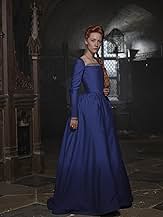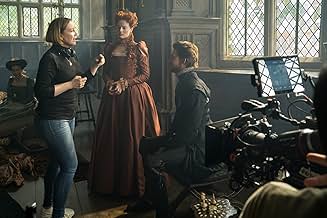Il tentativo di Mary Stuart di rovesciare sua cugina Elisabetta I, regina d'Inghilterra, la vede condannata a anni di prigione prima di essere giustiziata.Il tentativo di Mary Stuart di rovesciare sua cugina Elisabetta I, regina d'Inghilterra, la vede condannata a anni di prigione prima di essere giustiziata.Il tentativo di Mary Stuart di rovesciare sua cugina Elisabetta I, regina d'Inghilterra, la vede condannata a anni di prigione prima di essere giustiziata.
- Candidato a 2 Oscar
- 8 vittorie e 31 candidature totali
Recensioni in evidenza
It's only my love for Saoirse Ronan and Adrian Lester that I kept it on. It was Disney-fied in the casting area as there were no people of colour as nobleman or indeed in the court at that time. Mary's accent is not accurate as she was raised in France. And they didn't all wear black. It was like rowan atckinson's black adder. The subject matter is intense as extreme misogyny meets religious hypocrisies! Well
Shot and acted by ALL.
Soarise Ronan is NO Vanessa Redgrave and Margot Robbie is NO Glenda Jackson. This is such a weak, denatured telling compared to the more glorious 1971 version; and yes, admittedly it was based on Maxwell Anderson's play. But it was precisely Anderson's language that gave the 1st go-around such dramatic fireworks. This one is a lame, telegrapher version that tailors the story to the camera; and similarly, panders to PC-ness by casting so many minorities in the Scot and English courts. REALLY? It is so distracting and a travesty on history and does a disservice to the paying movie-goer by feeding into that "casting diversity" BUT WHOLLY FALSE Representation, of historical fact. The hairdos of the 2 queens are quite silly and again, dressing all the men in BLACK and just giving color to the queens' costumes betrays such self-conscious techniques that they are all doing these FOR THE CAMERA, not in the interests of historical accuracy. Quite disappointing.
Director Josie Rourke appears to want to tell the historical story of Mary Queen of Scots and her cousin, Queen Elizabeth the first, as she would have liked it to be, shown in fashionable 21st century terms, not how it was in the 16th Century. I read that Josie was determined to have a mixed race cast and I ask the reader, why? The events took place at a time when not too many non white people inhabited England, let alone took their place as royal courtiers. This is clearly nonsense and I found some of the casting a distraction that spoilt an otherwise fairly decent film, other than an event at the close that brings the two women together in an unconvincing tearful meeting. I say unconvincing, not just because these two strong women would have been unlikely to act like two blubbering soap actresses but that there is no evidence that they ever met. Having said that, most of the rest of the film is fairly accurate that I can see, the rivalry between Mary and Elizabeth, a slaughter of Mary's aide, the murder of her husband and Mary's ultimate beheading. These are all things that may be common knowledge to many so I'm not sure if they count as spoilers or not. Soairse Ronan is well cast as Mary although I'm not sure she is pretty enough as Mary has been described in history. The supporting actors on the whole, apart from some miscasting, are on the whole excellent, David Tennant, Ian Hart, Brendan Coyle and Martin Compson are all strong. The real standout for me is a chilling performance by a heavily made up Margot Robbie as Queen Elizabeth who out acts everyone else in the movie. Josie Rourke had the opportunity to make a really good movie here but has blown it by introducing these modern woke ideas already mentioned, not just by me but by others. I'd suggest she avoids the woke nonsense if she wants her films to make a decent profit and to be remembered in the future.
I only watched this movie because my wife likes historical costume drama's. The history of Mary Stuart was the subject I thought that would be interesting but the more I watched it the more I had the feeling this wasn't an accurate telling of facts. For example I really doubt there would be a Black lord or an Asian countess at that time in England. Add on that the rather boring repetitive story telling and you get just a mediocre movie. The main actresses Saoirse Ronan and Margot Robbie didn't do a bad job but the inaccuracy of the story just made Mary Queen Of Scots a movie I will forget everything about it in a week.
Historic authenticity is cast to the wind in this revisionist costume drama that feels like it was written by a freshman Women's Studies major. Directed by Josie Rourke with a screenplay by Beau Willimon, Mary Queen of Scots (2018) was based on the book Queen of Scots: The True Life of Mary Stuart by John Guy. Like many films released this year, it has strong female leads, a diverse cast, and progressive social messaging, but checking all the right boxes on the SJW playlist wasn't enough to save this film from mediocrity.
The year is 1560, and the young and beautiful Mary Tudor (Saoirse Ronan) returns home, where she is out of place in a dreary Scottish castle. Her half-brother, James, Earl of Moray (James McArdle), has been ruling as regent, alongside a bevy of colorless and perpetually-angry Protestant men. Her appearance in Scotland alarms her cousin, Queen Elizabeth I of England (Margot Robbie). Elizabeth, a Protestant, is not seen as a legitimate ruler by her Catholic subjects. She seeks to gain influence over Mary by arranging a marriage with Elizabeth's own lover, Robert Dudley (Joe Alwyn).
Instead, Mary marries the charming and charismatic Lord Henry Darnley (Jack Lowden), who pulls a Jeckyll-and-Hyde routine and becomes a drunken lecher on their wedding night. Things get complicated for the childless Queen Elizabeth when Mary becomes pregnant, producing an heir for her dynasty and strengthening her claim to the English throne. Can Mary fend off attacks from her domestic critics and convince Elizabeth to acknowledge her as England's rightful ruler?
Mary Queen of Scots couldn't decide whether it wanted to be a film about the rivalry between two queens or a revisionist biopic of its titular character, so it does neither particularly well. This ill-conceived and poorly executed film also missed a chance to let its leading ladies shine. As Queen Elizabeth, the talented Margot Robbie goes to waste as a costumed mannequin who practically disappears for the middle third of the film.
Historically, Mary Stuart was born in 1542, the only legitimate heir to Scottish King James V. She was briefly married to the King of France. After his untimely death in 1560, Mary returned to Scotland and ruled as Mary I of Scotland until 1567, when she was forced to abdicate after her second husband's murder (which her rivals accused her of orchestrating). She fled to England to seek protection from her cousin, Queen Elizabeth I, but many English Catholics considered Mary the legitimate Queen of England, so Elizabeth had her imprisoned and later executed.
There are many anachronisms and inaccuracies throughout Mary Queen of Scots, not the least of which was "colorblind casting" that falsely portrays 16th-Century England and Scotland's aristocracy as racially diverse. Mary's Scottish accent was also out of place (she grew up in France), as was her friendship with Italian courtier David Rizzio/Riccio. Most historians acknowledge Mary was probably having an affair with the man, which infuriated her Second Husband. Rizzio might have been bisexual, but he wasn't "one of the girls," as the film portrays.
Though ostensibly based on a book, this film can be considered a remake of the 1971 film by the same name. Mary, Queen of Scots (1971) was directed by Charles Jarrott and starred Vanessa Redgrave and Glenda Jackson. Like the 2018 film, the 1971 version featured a fictional meeting between the two queens and speculated that Lord Darnley and the musician David Riccio were lovers. The two films part ways, however, when it came to Mary's imprisonment. The 1971 version devotes more screen time to her 19 years in English captivity, while this version fast-forwards through it.
Mary Queen of Scots opened to mixed reviews and currently holds a 63% positive rating from critics and 44% audience favorability on RottenTomatoes. Its opening weekend took in a painful $194,777 on a $25 million budget. A successful film gets the audience invested in the story. Mary Queen of Scots ultimately failed to connect with audiences because it was more concerned with pushing the filmmaker's social perspective than making us care about who gains the English throne.
The year is 1560, and the young and beautiful Mary Tudor (Saoirse Ronan) returns home, where she is out of place in a dreary Scottish castle. Her half-brother, James, Earl of Moray (James McArdle), has been ruling as regent, alongside a bevy of colorless and perpetually-angry Protestant men. Her appearance in Scotland alarms her cousin, Queen Elizabeth I of England (Margot Robbie). Elizabeth, a Protestant, is not seen as a legitimate ruler by her Catholic subjects. She seeks to gain influence over Mary by arranging a marriage with Elizabeth's own lover, Robert Dudley (Joe Alwyn).
Instead, Mary marries the charming and charismatic Lord Henry Darnley (Jack Lowden), who pulls a Jeckyll-and-Hyde routine and becomes a drunken lecher on their wedding night. Things get complicated for the childless Queen Elizabeth when Mary becomes pregnant, producing an heir for her dynasty and strengthening her claim to the English throne. Can Mary fend off attacks from her domestic critics and convince Elizabeth to acknowledge her as England's rightful ruler?
Mary Queen of Scots couldn't decide whether it wanted to be a film about the rivalry between two queens or a revisionist biopic of its titular character, so it does neither particularly well. This ill-conceived and poorly executed film also missed a chance to let its leading ladies shine. As Queen Elizabeth, the talented Margot Robbie goes to waste as a costumed mannequin who practically disappears for the middle third of the film.
Historically, Mary Stuart was born in 1542, the only legitimate heir to Scottish King James V. She was briefly married to the King of France. After his untimely death in 1560, Mary returned to Scotland and ruled as Mary I of Scotland until 1567, when she was forced to abdicate after her second husband's murder (which her rivals accused her of orchestrating). She fled to England to seek protection from her cousin, Queen Elizabeth I, but many English Catholics considered Mary the legitimate Queen of England, so Elizabeth had her imprisoned and later executed.
There are many anachronisms and inaccuracies throughout Mary Queen of Scots, not the least of which was "colorblind casting" that falsely portrays 16th-Century England and Scotland's aristocracy as racially diverse. Mary's Scottish accent was also out of place (she grew up in France), as was her friendship with Italian courtier David Rizzio/Riccio. Most historians acknowledge Mary was probably having an affair with the man, which infuriated her Second Husband. Rizzio might have been bisexual, but he wasn't "one of the girls," as the film portrays.
Though ostensibly based on a book, this film can be considered a remake of the 1971 film by the same name. Mary, Queen of Scots (1971) was directed by Charles Jarrott and starred Vanessa Redgrave and Glenda Jackson. Like the 2018 film, the 1971 version featured a fictional meeting between the two queens and speculated that Lord Darnley and the musician David Riccio were lovers. The two films part ways, however, when it came to Mary's imprisonment. The 1971 version devotes more screen time to her 19 years in English captivity, while this version fast-forwards through it.
Mary Queen of Scots opened to mixed reviews and currently holds a 63% positive rating from critics and 44% audience favorability on RottenTomatoes. Its opening weekend took in a painful $194,777 on a $25 million budget. A successful film gets the audience invested in the story. Mary Queen of Scots ultimately failed to connect with audiences because it was more concerned with pushing the filmmaker's social perspective than making us care about who gains the English throne.
Lo sapevi?
- QuizThe first time Saoirse Ronan and Margot Robbie saw each other in character was during the scene where they meet for the first time. They rehearsed separately, and Robbie's scenes were completed the day Ronan began hers.
- BlooperDarnley wasn't exiled to Kirk o' Field, he was sent there with the pox, for medical quarantine.
- ConnessioniFeatured in Front Row: Episodio #3.3 (2018)
I più visti
Accedi per valutare e creare un elenco di titoli salvati per ottenere consigli personalizzati
- How long is Mary Queen of Scots?Powered by Alexa
Dettagli
- Data di uscita
- Paesi di origine
- Siti ufficiali
- Lingue
- Celebre anche come
- Las dos reinas
- Luoghi delle riprese
- Aviemore, Highland, Scozia, Regno Unito(on location)
- Aziende produttrici
- Vedi altri crediti dell’azienda su IMDbPro
Botteghino
- Budget
- 25.000.000 USD (previsto)
- Lordo Stati Uniti e Canada
- 16.468.499 USD
- Fine settimana di apertura Stati Uniti e Canada
- 194.777 USD
- 9 dic 2018
- Lordo in tutto il mondo
- 46.712.809 USD
- Tempo di esecuzione2 ore 4 minuti
- Colore
- Mix di suoni
- Proporzioni
- 2.39 : 1
Contribuisci a questa pagina
Suggerisci una modifica o aggiungi i contenuti mancanti

Divario superiore
What is the streaming release date of Maria regina di Scozia (2018) in Canada?
Rispondi




































